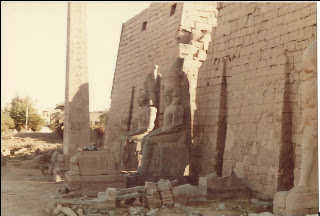Obelisks represented the benben, or sacred stone of the sun god at Heliopolis. They were erected at temple entranceways by numerous pharaohs, including Tuthmose III, Hatshepsut and Ramesses II. Obelisks were carved from one huge block of granite and floated downstream to wherever they were to be erected. A carving in the temple of Hatshepsut at Dier el-Bahri shows how the ancient Egyptians did this.
 A number of Egyptian obelisks have been moved from Egypt to other countries. Augustus Caesar began this by moving a couple of obelisks from Egypt to Rome. Obelisks so fascinated the Romans that Pliny devoted a full chapter of his book Natural History to them.
A number of Egyptian obelisks have been moved from Egypt to other countries. Augustus Caesar began this by moving a couple of obelisks from Egypt to Rome. Obelisks so fascinated the Romans that Pliny devoted a full chapter of his book Natural History to them.Ramesses II erected two obelisks in front of the entrance of the Luxor temple. The obelisk now in the Place de la Concorde in Paris is one of these two. It was brought to Paris in December of 1833. On October 25, 1836, King Louis-Philippe had it placed in the center of the Place de la Concorde.
The first photo, which I took a couple of days ago, shows the obelisk as it now stands in Paris. The second photo is a picture I took back in the 1980's of the first pylon of the Luxor temple. You can see one of Ramesses' obelisks still in place, with an empty base in the foreground where the obelisk in Paris once stood.
All photos copyright 2012 by John Freed





No comments:
Post a Comment